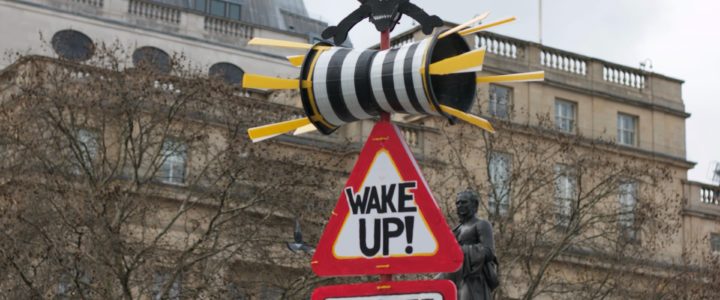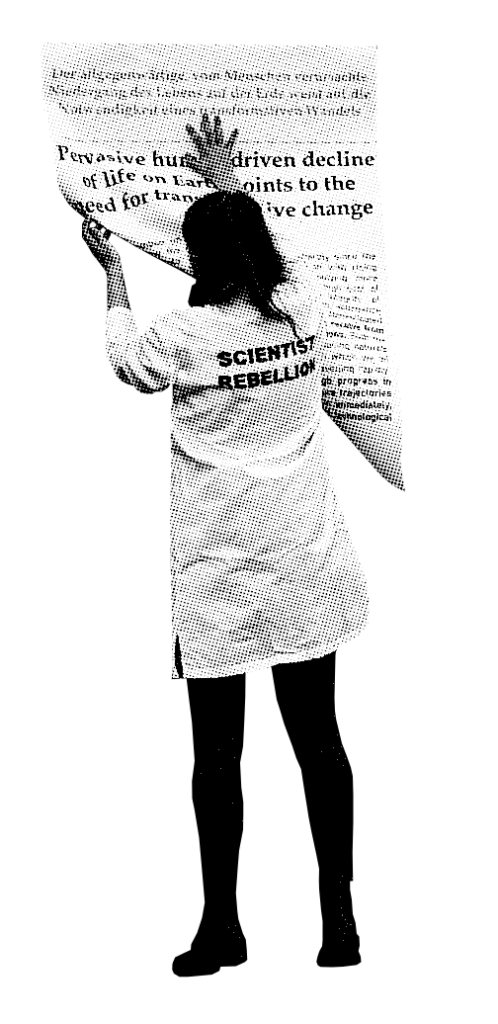
There are fewer and fewer places to hide from the stark (read: completely terrifying!) reality of the worsening climate crisis. The facts are in. The science is, surely, at this point, indisputable. There has been a very clear consensus among scientists for such a long time. But they’re fed up with only being the bearers of this sobering news. While there’s been some controversy over how best to communicate the scientific facts in succinct, accessible language, to then enable widespread conversations and behavior change – it seems they’ve gotten itchy feet sitting behind their desks and in their labs. They’ve been providing the data for us to act on for decades, but quite frankly, we’ve been letting them down. So now a growing group of scientists are taking to the streets in acts of non-violent civil disobedience.
They have formed “Scientist Rebellion” (SR), which works within the framework of Extinction Rebellion (XR). The majority of their members are scientists or academics from a wide variety of scientific backgrounds from all around the world. The group was formed only recently, in September 2020, but have already got some widely publicized, dramatic (and illegal) operations under their belt.
During the Northern Hemisphere Fall and Winter of 2020/2021 there was a campaign within prestigious universities in the UK and Ireland, pasting giant climate related articles to the walls – all written by students or alumni, to highlight the university’s hypocrisy; and occupying the offices of senior faculty staff.

Then in March 2021, there was a global protest by SR, where more than 100 scientists in 15 countries engaged in civil disobedience. Again pasting giant scientific papers to walls, but also adding teach-ins and hunger striking to their repertoire.
During the much-sledged COP26 in Glasgow in November 2021, the group upped the ante. They pasted enormous scientific papers onto buildings, but in a far more visible protest, they padlocked and chained themselves together to block a busy bridge (leading to 21 arrests, 15 of them scientists),. They held more teach-ins to bust myths of so-called solutions to the climate crisis (planting trees and capturing carbon will not, actually save us), threw green paint onto the walls of ScottishPower to symbolize the company’s greenwashing, glued themselves to the walls and floors of this same building (until each was safely unglued and arrested). and floated down the river with a “Tell the Truth” banner (until that scientist, too, was arrested).
But all of these past actions were outdone a few days ago, when Scientist Rebellion held another global action – this time attracting more than 1,000 scientists and academics from over 25 countries! All acts of civil disobedience were non-violent and no harm came to anyone, but there were plenty of police present at all sites and dozens of arrests, including that of Dr Peter Kalmus, renowned climate scientist and passionate climate action communicator.
Leading by example is one of the most powerful ways to influence others
Charlie Gardner
Dr Tim Hewlett is the co-founder of Scientific Rebellion, and has not minced words about the reason for SR coming into being. Essentially, he cites the last 30 years of IPCC work (the first Intergovernmental Panel on Climate Change report was released in 1990) as an “unmitigated failure” of scientists to effectively do anything about the existential crisis which is torpedoing towards us. Everything the scientific community have been doing – research, report, rinse and repeat – has been consistently falling on deaf ears. So he took it upon himself to rally a group of increasingly frustrated lab-coat-wearers to put their bodies on the line and participate in civil disobedience. One of the slogans of SR is ‘inaction is denial’, to highlight that it’s not enough to say something is true if you don’t act like it’s true. These learned individuals understand that if their words are to be taken seriously, they must act as if the situation is serious, and thereby participate in some pretty serious disobedience actions. Although for some in the academic world there is fear of retribution and loss of their position, others, like Charlie Gardner, a conservation biologist and outspoken member of SR, and someone familiar with activism for over 30 years, simply believe that there “are no professorships on a dead planet”.

Dr Hewlett believes that being an activist is “to live ethically, to do what you can”, and that, for the scientific community, is to stop writing about the impending doom and start screaming about it from the rooftops, defacing buildings to highlight contradictions and disrupt normal life. On this note, it’s important to see a few differences from XR with the operation of SR. The biggest is that Scientist Rebellion use ‘Technological Decentralization’, which means they use open source, secure technology to connect activists with each other. An academic looking to get involved can be put in touch with others in their area, and the the ball is in their court to organize and carry out local actions. SR use ‘Facilitated Horizontalism’ to ensure that there’s no central leader required to get an action off the ground. At any time you can jump onto their website and find resources for arranging and then carrying out an action – like how to mix and then effectively throw paint, how to mix paste for plastering walls with scientific documents, some examples of scientific documents which would look good enlarged 20x and then glued onto buildings, educational talking points for running teach-ins etc. They have a fantastic amount of resources, available to anyone at any time – because rapid growth of the movement is paramount. Finally, they support any and all non-violent action, unequivocally. It’s important to understand that this movement is not about making friends – people will be disrupted and offended…but if they weren’t it wouldn’t make for a very strong, memorable message. Hewlett, in a recent podcast interview, highlighted the disruption you might experience from their blocking of a bridge pales in comparison to how your life, and your children’s lives, will be turned upside down as we plummet deeper into the climate crisis.
I recommend you take a look at the Scientist Rebellion website, follow them on all the socials, and join them when they take action in your local area. If you know any academics, encourage them to get involved with the direct actions, and by signing the SR Demands Letter. The best time to act to mitigate the impacts of the climate crisis was 30 years ago. The second best time is NOW.




